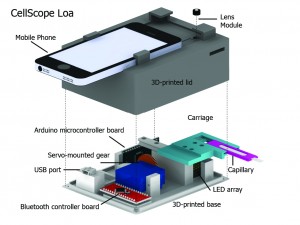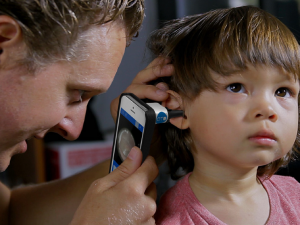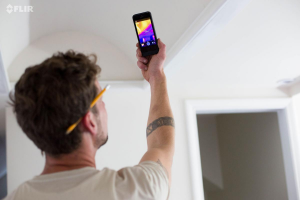Smartphones, laptops and tablets have now become integral parts of our lives. This has influenced the engineering community too. We are noticing engineers aggregating specialised tools with consumer devices like personal computers (PCs), laptops, tablets and smartphones, to achieve great and useful purposes. Here are a few interesting examples of how consumer devices are being leveraged to increase the reach of technology and make our lives easier.
Smart diagnoses

(Image courtesy – Mike D’Ambrosio & Matt Bakalar, Fletcher Lab, UC Berkeley)
Started in 2009, CellScope is a project by UC Berkeley’s Fletcher lab that works on using the cameras of smartphones and tablets to collect images and videos for scientific, educational and medical purposes.The team adds optics, illumination and hardware automation to mobile phone and tablet cameras to create mobile microscopes and diagnostic solutions. They also develop custom software for each mobile microscope application to coordinate image collection, annotation, data management, Web connection and automated image analysis.
3D-printed fight against parasites: Named as CellScope Loa, this small 3D printed box equipped with a high-resolution lens and an Arduino microcontroller board, is a complete diagnostic solution that uses a single drop of blood to automatically detect and quantify loa loa, the parasite that causes Loa loa filariasis (eye worm) disease. With the help of of a high-resolution lens placed directly under the phone camera, the motion sensor in the device detects the wriggling movement of loa loa worms in the blood. The Arduino processes this information and sends it to the smartphone app via Bluetooth. This technology would help control, and eventually eradicate this and other diseases in Africa and other parts of the world where proper healthcare facilities are not available.

Detecting ear infections: According to statistics, five out of six children have at least one ear infection by the time they are three years old. Such infections are usually detected by doctors using a device called an otoscope or auriscope. Prototyped in the UC Berkeley lab and manufactured by CellScope Inc., Oto HOME is an iPhone attachment that serves this purpose.
Fitted on top of the phone camera, it lets parents easily obtain high-quality images of the inside of an ear, and send the video to a doctor over the Internet, for diagnosis and prescription. Oto CLINIC, an advanced version of the same device, has a more powerful digital otoscope, targets clinicians and offers additional services such as a Web server to store each patient’s medical history along with the images and footages.
The device is lightweight and conical, and works with iPhone 5, 5S or 6. It is ergonomically-designed and integrates seamlessly with the mobile application using a Bluetooth connection.
Visualise temperature with a smartphone

Do you always require a thermal imager to obtain thermal images? No, proves FLIR ONE, which combines a small piece of hardware that appends to Android and iOS smartphones and a mobile app to create thermal images of normal objects. This is mainly targeted at domestic applications such as checking the energy efficiency of a home, detecting irregularities in a car engine, fixing plumbing and electrical issues, and detecting the presence of a person in the dark.
T&M with smartphones/tablets
The test and measurement (T&M) industry has also started introducing smartphone and tablet control for instruments. This enhances portability of the instrument, lets users take measurements in harsh conditions without actually being present there (thereby increasing safety), and allows remote logging of measurements in real time. Here are a few examples:
Keysight U1177A/U1117A. These are IR-to-Bluetooth adapters compatible with several Keysight handheld digital multimeters (DMMs) and clamp meters. They collect data on iOS and Android smartphones as well as PCs.
NI VirtualBench. An all-in-one instrument, this collects data on iPads and Windows- based tablets and PCs.
R&S TSMA. This is an autonomous mobile network scanner that collects data on Android smartphones and tablets.
The popularity and influence of consumer appliances and the increasing need for portability have created innovative engineering applications that work with smart devices. This movement would hopefully lead to betterment in different walks of life including personal health and security. Let us look forward to more of such applications.
The author is a dancer, karaoke aficionado, and a technical correspondent at EFY. Find her on Twitter @AnuBomb.







